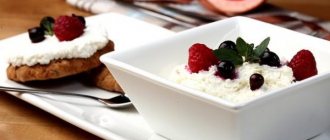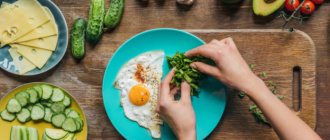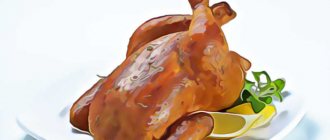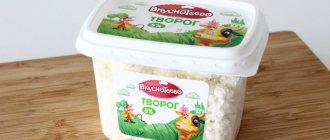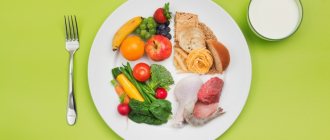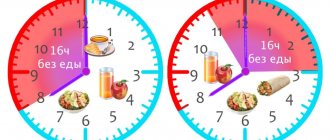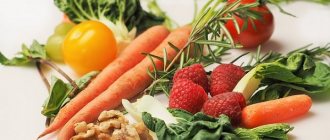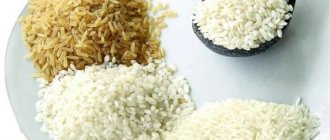The essence of a low-calorie diet
The specificity of a low-calorie diet is obvious, it follows from the name - it assumes a low bar for the total number of calories consumed. People who want to lose weight need this regimen.
The term “low-calorie” is used in two meanings: narrowly, denoting a specific diet with its three types, and broadly, meaning any nutritional system based on reducing food intake, which leads to a decrease in calorie content.
Low-calorie nutrition has two directions:
- reduce the total calorie content of foods;
- consume foods low in calories.
They, as a rule, are combined with each other, but the main principle remains unchanged: nutrition should be limited.
There are tables from which you can find out how many kilocalories a person should consume per day, depending on his gender, height, age, and occupation. The numbers vary, but there is a certain basic daily nutritional value, that is, the number of kilocalories that the body needs so that it can maintain its needs. For the average woman this level is 1200 kcal/day, for the average man it’s a little more – 1400 kcal/day.
The approach is simple: if a person consumes a larger volume of calories without having high energy costs (hard physical work, sports training), then the food will be processed into fat and stored in reserve, that is, the person will gain weight; if he consumes less, then exhaustion will occur.
Structure of a low-calorie diet
Using the products from these tables will help you adjust your diet and independently select products for your daily menu.
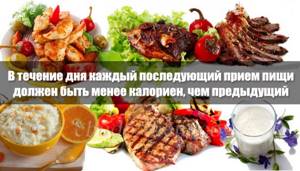
The structure of a low-calorie diet should be built as follows:
- In the morning - porridge, fruits, allowed sweets.
- Lunch – liquid hot dishes, protein dishes, vegetables.
- Dinner – protein and some low-calorie vegetables.
- Snacks – low-fat dairy products, fruits and vegetables in small quantities (100-150g).
The closer it gets to the evening, the less caloric the food should be . In the evening, activity usually decreases, so it will no longer be possible to burn a large number of calories and, as a result, they will be deposited in your problem areas.
Calorie base and its factors
A low-calorie diet is a diet in which the body is placed in conditions where it is forced to burn more energy than it consumes.
Each person has their own calorie base, when reduced, the process of weight loss begins, and it is better if a professional nutritionist helps you calculate it.
Here are the factors to consider:
- age (the body’s metabolism depends on it; the older the person, the slower the metabolism);
- gender (in men, compared to women, energy consumption is 200-300 kilocalories more, mainly due to muscle mass);
- lifestyle (sedentary or energy-intensive);
- previous diet (how correct or incorrect the person followed);
- chronic diseases (are there any contraindications);
- psychological state (ability to withstand a dietary test without breakdowns).
A person who decides to master a low-calorie diet must be prepared for culinary accounting. You will need to acquire tables of caloric content of dishes, since they are the basis for constructing a menu. You will have to scrupulously count calories, add them up, and write them down so as not to forget or get lost. Now, in an era where everyone has a mobile phone with a built-in calculator at their fingertips, this process has become much easier.
Gender differences should be taken into account, since they are of no small importance, expressed as follows:
| Factor | Men | Women |
| Number of meals/day | At least 5 | 6 |
| Daily calorie content | Up to 1400 kcal | 1200 kcal diet |
| Volume of dishes | 300 g | 200 g |
| Last meal | 2 hours before bedtime | Do not eat after 18.00 |
| Water regime/day | 2.5-3 l | Up to 2 l |
Important points of a low-calorie diet
To make the diet more effective, during the weight loss cycle you need to switch to fractional meals and follow additional recommendations:
• you need to eat not three times a day, but five or even six;
• portion sizes should be small - approximately half of the usual portions;
• the weight of food that fits on your plate should not be more than 300, maximum 350 grams;
• during the day, in order to reduce the load on the kidneys, you need to drink as much clean water as possible. It’s good if you manage to drink 2 liters, the minimum norm is 1.5 liters;
• you don’t need to starve after six in the evening, but you shouldn’t overeat before bed. The ideal option is a hearty dinner at seven in the evening or a light one two hours before bedtime.
Since the diet includes a variety of foods, additional vitamin intake is not necessary. However, if you drink them in a course, then you do not need to stop during the diet.
you add daily physical activity to a low-calorie diet , the weight loss process will be even more intense. It is not necessary to run to the gym every day; home workouts, yoga classes, long walks, swimming, etc. are enough.
Rules and principles of a low-calorie diet
The low-calorie system has its own rules and principles, they can be formulated as follows:
- fractional intake (food should be divided into small portions, taken 5-6 times a day);
- maintain a drinking regime (1.5-2 l/day);
- the amount of fat should not exceed 80 g/day (mainly fats of vegetable origin);
- the amount of complex carbohydrates should not exceed 100 g/day (preferably in the form of vegetables, fruits, nuts);
- the basis of nutrition should be proteins (their digestion requires more energy, muscle tissue is preserved);
- when preparing dietary food, preference is given to boiling, baking, stewing, and steaming;
- fast carbohydrates (sugars) are completely excluded from the diet;
- cholesterol-containing foods are sharply reduced (egg yolks, hard cheeses, bacon, lard, brains, butter);
- alcohol of any kind is excluded (not so much because of the harm to health, but because of its high calorie content);
- salt consumption is limited (up to 3-4 g/day), it is advisable to replace plain salt with iodized salt;
- avoiding foods that can increase appetite (hot spices, seasonings, pickles, marinades, smoked foods, canned foods);
- to prevent vitamin starvation, the body is provided with a vitamin-mineralized complex;
- last meal no later than 4 hours before bedtime.
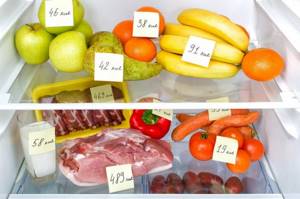
The best low-calorie diets

Rating
- Northern.
- South.
- ABC.
- Protein.
- Model.
- Drinking.
- Japanese.
- Maggi.
- Protasov's diet.
- Malysheva's diet.
Review of the most popular
North and South
Two diametrically opposed diets have recently gained great popularity - Mediterranean (southern) and Scandinavian (northern, Nordic, Norwegian). However, they have many common points: they are based on a healthy diet and are low-calorie. If your goal is to lose weight without harming your health, choose them.
Basic principles:
- reducing calories to a safe level (1,400-1,600);
- limiting animal fats, salt and spices;
- emphasis on seasonal fruits and vegetables characteristic of a particular region;
- all dishes are prepared at home;
- giving up trans fats and fast food.
The basis of the diet on the Mediterranean diet is fruits and seafood (for lists of products, menus, recommendations, see the link). If you lose weight according to the Scandinavian method, the menu includes berries, reindeer meat and fish, which is found mainly in northern waters.
Protein
A low-calorie protein diet is good because, when simultaneously exercising, it prevents the breakdown of muscle fibers (protein is a building material for them). This forces the body to burn fat deposits. Has many options. It can be an emergency three-day and a month long. The daily calorie level ranges from 800 kcal to 1,800. The basis of the diet with a minimum of carbohydrates and fats is:
- chicken or turkey breast;
- egg white;
- mushrooms, nuts and legumes, if we talk about vegetable protein;
- all dairy products with a low fat percentage: cottage cheese, milk, kefir, hard cheese, yogurt, natural yogurt.
Good results can be achieved with a low-calorie dairy diet, which is also a protein diet. It involves active consumption of milk during the day (500-600 ml) while limiting other products. More detailed information about its compliance can be read here.
ABC
This is the lowest calorie diet. Originally developed for training American military personnel. ABC is the short name for the military camp where this system was practiced: Aha Boot Camp. The daily calorie content on different days varies from 0 to 850 kcal, but does not rise higher. Scientists were involved in calculating these indicators, so there is no accident in them. For example, this is what the first week’s meal plan looks like:
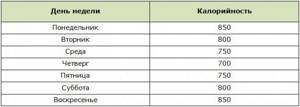
These numbers are gradually decreasing every week. Two diet options were introduced for a period of 30 and 50 days. The latter was the most extreme and was not followed by everyone. At the same time, military personnel had to actively engage in sports, and the diet was predominantly protein.
Despite warnings from nutritionists and doctors that the ABC diet is an extreme way to lose weight and is not intended to be followed at home, many people practice it. Of course, few people can withstand 30 or even more so 50 days on such a diet, but 3, 5 and 7-day options give good results. True, with a lot of side effects and complications.
Products for diet
The expected question is what can you eat that is non-caloric? The list below contains most of the low-calorie foods that are suitable for the diet.
- vegetables in any form (raw, boiled, stewed), vegetable dishes;
- any fruits (it is advisable to limit bananas and grapes);
- cereal porridge with water (except manna and pearl barley);
- dairy products (low fat);
- eggs of any preparation;
- lean meat (veal, beef, rabbit);
- poultry without skin (chicken, turkey);
- any fish and seafood;
- mushrooms, nuts, berries.
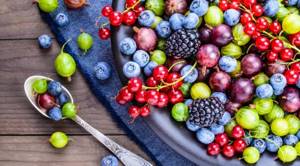
Pros of a low-calorie diet
The benefits that such a system brings to its adherents are impressive:
- High rates of weight loss, especially at the initial stage. In the first 7 days, it is possible to lose up to 5 kg of excess weight, then the pace slows down, but still remains relatively high: 1-3 kg per week. The slowdown in the rate of weight loss occurs because the body gets used to the new regime, begins to adapt to it, using a more economical metabolic option
- An improvement in general condition is recorded (blood pressure normalizes, blood sugar levels level out, cholesterol levels drop).
- Due to the wide selection of permitted products and a varied menu, there is no nutritional stress caused by a reduction in traditional portions.
- Balanced ratio of carbohydrates, fats and proteins in the correct proportions.

Low calorie diet for vegans
A vegan diet rejects all animal products and prefers plant-based foods. Therefore, a vegan excludes from the diet not only meat, but also other animal products, such as eggs, milk, honey. Despite this, when creating a menu for a low-calorie diet for weight loss, there will be no problems with recipes. Simply, animal proteins, which the body cannot do without, can be replaced with vegetable proteins (soy meat, tempeh). In particular, tempeh, produced by fermentation using noble mold, is considered an excellent meat substitute.
Soy tofu is also an important food for vegans. Seitan, a protein derived from wheat, is beneficial. When stripped of starch and prepared correctly, it is a suitable component of a low-calorie vegan diet.
When following a vegan diet, it is important to ensure adequate intake of the following:
- omega-3 fatty acids (flaxseed);
- iron (whole grains, dark leafy vegetables);
- proteins (legumes - lentils, beans);
- calcium (broccoli, sesame, soy milk).
A person who wants to adhere to a vegan lifestyle for a long time must become familiar with all these products, learn how to process them, and carefully read their composition in order to give the body all the necessary substances.
Example of a vegan diet menu:
Day 1:
- Breakfast: muesli.
- Snack #1: apple, flaxseed.
- Lunch: vegetable risotto.
- Snack #2: Soy yogurt.
- Dinner: beans.
Day 2:
- Breakfast: millet porridge, seitan.
- Snack #1: orange, flaxseed.
- Lunch: tofu with sauerkraut.
- Snack #2: Walnuts.
- Dinner: corn tortillas, vegetables.
Day 3:
- Breakfast: oatmeal with almond milk.
- Snack #1: kiwi, flaxseed.
- Lunch: lentils with pickled cucumber.
- Snack #2: Tofu.
- Dinner: vegetable soup.
Day 4:
- Breakfast: soy sausages with mustard, whole grain bread.
- Snack #1: grapefruit, flaxseed.
- Lunch: rice with olives, tomatoes.
- Snack #2: Banana smoothie.
- Dinner: red lentils, pickled peppers.
Day 5:
- Breakfast: bulgur with tempeh.
- Snack #1: pear, flaxseed.
- Lunch: soy cubes with vegetables.
- Snack #2: Vegetable chips.
- Dinner: seitan with vegetables.
According to reviews, a low-calorie diet for vegans will help you get rid of about 2 kg per week and maintain your achieved body weight.
Cons of a low-calorie diet
But do not forget about the possible disadvantages that you will have to face:
- Only 20% of lost pounds come directly from fat tissue. 80% is water, intestinal contents and, most unpleasantly, muscle mass. After returning to a normal diet, you need to be prepared to regain about 80% of the lost weight.
- Deposition of stones and sand in the gall bladder (due to a decrease in calorie content, the volume of bile secreted decreases, not all fat is broken down, and cholesterol crystallizes in the gall bladder).
- Correctly counting calories is sometimes quite difficult (different types and varieties of the same product contain different amounts of calories), so errors in calculating the total calories consumed can reach 20-30%.
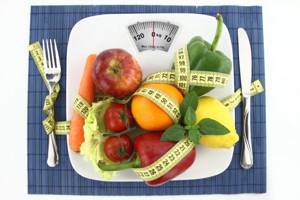
How to diversify your diet
We have not listed all low-calorie foods, but only the most basic ones. When thinking through your diet, it is important to understand which foods will go well with each other and can replace higher-calorie foods. Almost any familiar dish can be “lightened” if you try to find more dietary analogues
its constituent ingredients. Don’t focus on calories, just understand that you need to strive not for a strict diet, but for a balanced diet, and there are a lot of opportunities for this. Most of these foods are available fresh or frozen year-round, so your diet can be varied.
Types of Low Calorie Diets
There are 3 hardness options. Their differences are presented in the table:
| Type | Total energy content (kcal) | Protein content (g) | Fat content | Carbohydrate content |
| I (main) | 1200-1400 | 100-110 | 80-90 | 120-150 |
| II (moderately limited) | 1100-1200 | 70-80 | 60-70 | 70-80 |
| III (maximum-limited) | 650-1100 | 40-50 | 30-40 | 50-70 |
The main type, rather a type of low-calorie nutrition, is more suitable for maintaining the desired weight. Psychologically the most favorable.
The moderately limited type is the most optimal mode for effective weight loss.
The maximum-limited type is intended for patients with 3-4 degrees of obesity and for those who want to lose weight very quickly. There is significant mental stress.
The expected weight loss directly depends on the type chosen.
Type I gives a result of 1-2 kg per week, with long-term use, by the time the body adapts, weight loss stops and stabilization occurs.
Type II promises 3-4 kg in the first seven days, then 1.5-2.5 kg/week.
Type III allows you to lose 3-5 kg per week, but it is not recommended to practice it for longer than 10 days, since the harm caused to health may exceed the positive effect.
Physical activity on a low-calorie diet
As a complement to a low-calorie diet, it is necessary to include any physical activity in your daily program . This could be fitness, aerobics, cycling, swimming, etc. If you don’t have time for exercise, then:
- walk quickly;
- take the stairs without an elevator;
- overcome long corridors at work by running;
- do muscle exercises while in transport, alternately tensing and relaxing your muscles;
- buy a small ball, and while sitting at your office desk, squeeze it with your feet;
- find time for 15 minutes of morning exercises, getting up a little earlier or doing it in the evenings;
- do exercises while watching TV, combining business with pleasure.
If you wish, you can always find time for exercise by canceling some unimportant and non-urgent matters.
Here is a video about how important physical activity is when eating a low-calorie diet:
Menu for the week
A basic version of a low-calorie diet is offered - a menu for the day. Any products can be replaced with ones that are similar in calorie content and component composition.
| Day | Eating | Sample menu |
| Monday | Breakfast | Tea with honey (10-20 g) |
| Lunch | 100-150 low fat cheese | |
| Dinner | White cabbage salad with egg, seasoned with lemon juice | |
| Afternoon snack | Half an apple or orange | |
| Dinner | Lean beef baked in foil, vegetable salad (cucumbers, tomatoes, herbs), you can add garlic for those who can tolerate it | |
| Tuesday | Breakfast | Tea with honey (10-20 g) |
| Lunch | Lean meat (80 g), low-fat cheese (100 g) | |
| Dinner | Vegetable salad (cucumbers, tomatoes, herbs; medium-sized baked potatoes in their jackets | |
| Afternoon snack | Medium sized pear or apple | |
| Dinner | Boiled chicken breast (100-120 g); vegetable salad (cucumbers, lettuce) | |
| Wednesday | Breakfast | Tea with honey (100-120 g); Slice of fresh ginger |
| Lunch | 80-100 g low-fat cottage cheese, 2 dry bread | |
| Dinner | Fruit and vegetable salad (apple, white cabbage), seasoned with lemon juice, grilled cod (200 g) | |
| Afternoon snack | Citrus (orange, grapefruit) | |
| Dinner | Vinaigrette without potatoes | |
| Thursday | Fasting day | During the day in 6 doses: 1 kg of low-fat cottage cheese, 2.5 liters of mineral water such as “Borjomi”, “Narzan”, “Slavyanovskaya” |
| Friday | Fasting day | During the day in 6 doses: 2 kg of green apples, 2.5-3 liters of mineral water such as “Borjomi”, “Narzan”, “Slavyanovskaya” |
| Saturday | Breakfast | Oatmeal with milk; tea with crackers |
| Lunch | Tea with honey (10-20 g) | |
| Dinner | Low-fat cottage cheese (100 g), boiled chicken or turkey fillet (75-80 g) | |
| Afternoon snack | Medium sized pear or apple | |
| Dinner | Boiled or stewed chicken (100-120 g), vegetable salad (beets or carrots) | |
| Sunday | Breakfast | Tea with honey (10-20 g) |
| Lunch | Sandwich (slice of low-fat cheese, bread) | |
| Dinner | Fruit and vegetable salad (apple, white cabbage), seasoned with lemon juice, grilled cod (200 g) | |
| Afternoon snack | A glass of freshly squeezed citrus juice diluted with water | |
| Dinner | Vinaigrette without potatoes |
Sample diet menu for a week
When using a low-calorie menu, you need to eat 5-6 times a day, in small portions , the weight of which does not exceed 200-250g.
First you need to use a kitchen scale, then you will learn how to determine the weight of portions by eye. Low-calorie diet for a week menu minus 5 kg (for people with very high weight).
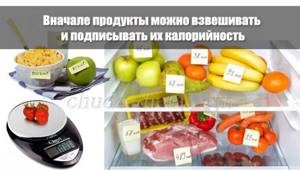
1
The first day:
- Breakfast: rice porridge, boil 3-4 tablespoons, add a little low-fat milk. You can add a handful of raisins, dried fruits;
- Second breakfast: grated apple;
- Lunch: chicken soup, cabbage salad;
- Afternoon snack: kefir 1-2%;
- Dinner: baked fish, tomato and cucumber salad.
2
Second day:
- Breakfast: omelet of one yolk and two whites with low-fat milk;
- Second breakfast: grated carrots;
- Lunch: boiled chicken, cucumber and herb salad;
- Afternoon snack: tomato juice;
- Dinner: beef meatballs, lettuce with olive oil.
3
Day three:
- Breakfast: low-fat cottage cheese with chopped orange;
- Second breakfast: baked apple;
- Lunch: stewed vegetables (carrots, cabbage, onions, herbs, zucchini, eggplant, pumpkin, whatever is available) with the addition of minced chicken;
- Afternoon snack: orange;
- Dinner: stewed fish, green pea and herb salad.
4
Day four:
- Breakfast: oatmeal with hot low-fat milk and berries;
- Second breakfast: baked or fresh pear;
- Lunch: vegetarian soup, boiled turkey, cauliflower salad with herbs and olive oil;
- Afternoon snack: kefir with berries, can be whipped in a blender;
- Dinner: boiled veal, grilled vegetables: tomatoes, carrots, onions, zucchini.
5
Day five:
- Breakfast: buckwheat porridge with low-fat milk and a little butter;
- Second breakfast: grapefruit;
- Lunch: chicken cutlets, salad of Chinese cabbage, herbs and fresh cucumbers;
- Afternoon snack: apple juice;
- Dinner: salmon steak or salmon, tomatoes.
6
Day six:
- Breakfast: millet porridge with milk, you can add some dried fruit;
- Second breakfast: low-fat yogurt without additives;
- Lunch: soup with veal meatballs, vegetable salad;
- Afternoon snack: bifidokefir with fresh berries;
- Dinner: two boiled eggs, cucumber salad, greens.
7
Day seven:
- Breakfast: cottage cheese casserole with one raw egg and chopped fruits or berries;
- Second breakfast: grated apple;
- Lunch: boiled or baked chicken breast, stewed vegetables (cabbage, carrots, zucchini, onions, peas, tomatoes);
- Afternoon snack: low-fat fermented baked milk;
- Dinner: boiled turkey, two tomatoes, two cucumbers.
Having understood the basic principle of this diet , it is not difficult to select products yourself. You can choose your favorite ones that you personally like and cook them more often than others. In addition to the main menu, you need to supplement your diet with weak tea or coffee without sugar . You can add low-fat milk. The total daily calorie content should not exceed 1200 kcal. Also pay attention to the 1200 kcal diet, its principles will also be useful to you.

In order for weight loss on a low-calorie diet to be successful, you need to know which low-calorie foods should form its basis. In the table you can find a list of products that can be used in the low-calorie diet menu . The table is convenient to use when choosing side dishes from vegetable dishes for protein dishes.
A month on a low-calorie diet
The menu for the month should be of the basic type - the most gentle. You can easily compose it yourself, guided by the following principles:
- taking into account the daily calorie content of foods (men - no more than 1400 kcal, women - no more than 1200 kcal);
- compliance with 6 meals a day;
- Any dairy products are allowed, but with reduced fat content;
- lean meat (baked or boiled, no more than 200 g/day);
- any vegetables (limit only potatoes and carrots);
- any berries (bananas and grapes are limited);
- eggs (preferably hard-boiled, 1-2 pieces/day)
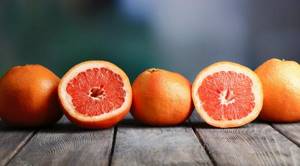
Low-calorie diet for weight loss: menu for the week
Although you can say goodbye to minus 5 kg by following a low-calorie diet menu for a week, remember that such weight loss is undesirable. Maximum - 1–2 kg.
Menu example:
Day 1:
- Breakfast: buttermilk with whole grain bread, green tea.
- Snack #1: apple/orange.
- Lunch: carrot and potato salad.
- Snack #2: kefir.
- Dinner: whole grain bread, unsweetened sparkling water.
Day 2:
- Breakfast: yogurt, whole grain bread, unsweetened coffee.
- Snack #1: raspberries/blueberries.
- Lunch: rice.
- Snack number 2: cottage cheese, fruit.
- Dinner: cabbage soup / tomato and pepper salad.
Day 3:
- Breakfast: eggs, whole grain bread, butter (daily butter consumption should not exceed 10 g).
- Snack #1: pear (or other fruit other than bananas).
- Lunch: vegetable salad / low-fat fish (cod, pike, pike perch).
- Snack #2: acidophilus milk.
- Dinner: vegetable soup.
When creating a low-calorie diet menu for the week, adjust your meals on the remaining days according to the example shown.
Winners stage – way out of the diet
The exit is desirable to be smooth and gradual. The best option would be to increase the daily intake by 50 kcal daily if diet therapy was carried out at a level below 1200 kcal/day. Having reached this mark, stay at it for 5-7 days, then increase your weekly calorie content by 100 kcal upon reaching the level of 2000 kcal. If weight loss began at 1200-1400 kcal, then the first stage is omitted.
Naturally, the products that are consumed at the exit should also belong to the category allowed on a low-calorie diet, the recipes for which should become a daily practice. We are talking only about increasing the total calorie content, but not about changing the principles of nutrition.
How to get out of a diet correctly?

Exiting the diet must be smooth, otherwise it will cause a strong blow to the body. First, you need to gradually increase the calorie intake per day by 150-200 kcal, adding fats and carbohydrates. For 2 weeks, monitor your weight and, if everything is normal, then you are allowed to add another 150-200 kcal. If you start to gain weight, then cut back on your calories again.
- Nail extension at home - lessons for beginners, video
- Allochol - instructions for use and reviews
- How to make an electronic signature
Certain types of low-calorie diets
In addition to the classic version, there are a number of low-calorie nutrition systems:
- Brazilian (more protein, coffee instead of tea) can adversely affect kidney function, so an increased volume of fluid intake is required (up to 3 liters). Effect up to 5 kg per week.
- Tokyo - protein mono-diet, designed for 6 days. The only dish is “chicken tobacco” up to 1kg/day. Effect 5-6 kg/week.
- Diet of "sinners" Paradoxically, it allows you to eat any forbidden delicacy every day, but the calorie content of the rest of the food taken per day along with the calories of the “forbidden fruit” should not exceed 1200 kcal. Effect 3-4 kg/week.
- Film diet. Lasts no more than 2 weeks. The menu includes lean meat, eggs, apples, tomatoes. Characterized by a pronounced feeling of hunger, effect 4 kg/week.
- Jockey. Protein hard 3-day. In this short period of time, it allows you to get rid of 3-5 kg, but with dangerous weakness and dizziness.
- 500 kilocalories is the apotheosis of low-calorie options. The essence is clear from the name. It is difficult to tolerate; consultation with a nutritionist is required. The effect can reach 7 kg in 10 days, but at what price do these kilograms come?

What other low-calorie diets are there?
Low-calorie diets that are recommended for people who control their weight include the following:
- Japanese diet for two weeks;
- diet 1200 kcal per day;
- diet for the lazy or water diet;
- chocolate diet;
- spicy diet, etc.
Each of the proposed diets has its own characteristics. But each of them has disadvantages.

For example, a chocolate diet involves eating only chocolate and coffee , which in principle cannot be beneficial, since the body does not receive vitamins, proteins, and minerals. A spicy diet is only suitable for those who do not have stomach problems, because abundantly flavoring all dishes with hot pepper can provoke inflammatory processes and lead to gastritis.
Recommended low-calorie recipes
Dietary vinaigrette
Components:
- carrots (2 pcs.);
- beets (1 pc.);
- sauerkraut (150 g);
- canned peas (2 tbsp);
- olive oil (1 tbsp);
- lemon juice (5 drops)
Preparation:
- Boil the vegetables.
- Cut them into cubes.
- Add peas and cabbage.
- Add salt and sprinkle with lemon juice.
- Mix.
Vegetable salad
Components:
- celery (100 g);
- cherry tomatoes (200 g);
- juice of 0.5 lemon;
- red pepper;
- lettuce;
- basil.
Preparation:
- Chop the celery.
- Beat in a blender with lemon juice.
- Chop other vegetables;
- Pour celery sauce over, add salt and stir.
Moderate diet menu
It is practically no different from the main diet menu, but involves fasting days three times over the course of one week. Fasting days can be varied as follows:
• eat 300 grams of apples, cucumbers or watermelon three times a day (do not combine different types of fruits and vegetables in one meal);
• three times a day, eat small portions of vegetable salad from permitted foods, seasoned with flaxseed, sunflower or olive oil. At the same time, you can eat a jar of natural low-fat yogurt;
• drink a glass of low-fat kefir six times a day;
• eat a portion of cottage cheese five times a day (no more than 120 grams);
• eat a piece of boiled meat five times a day (no more than 100 grams in weight);
• drink up to one and a half liters of freshly squeezed juice, rosehip decoction or herbal infusions.
You can stick to a moderate diet depending on how you feel for up to 3-4 weeks. Calorie counting is required. You can vary your diet on regular, non-fasting days as much as you like, without exceeding the allowed calorie content.
This diet option has a huge advantage: it allows you to return a distended stomach to physiological norm in just a week. Your health will not suffer, you will feel light and cheerful, and your skin will improve.
During the first stage of such a diet, the weight will rapidly drop (some young ladies manage to get rid of 3-4 kg), and this is very stimulating.
